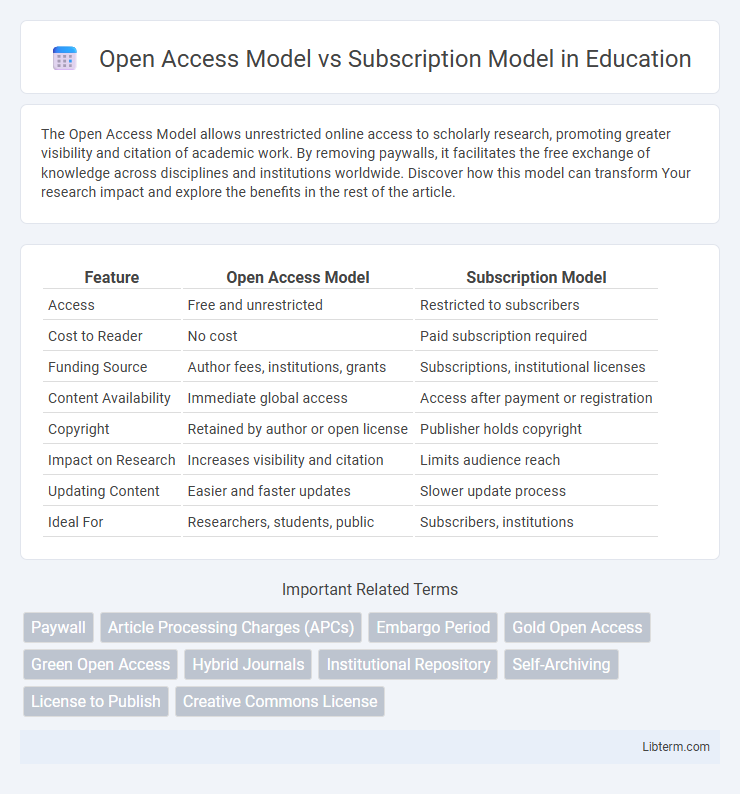The Open Access Model allows unrestricted online access to scholarly research, promoting greater visibility and citation of academic work. By removing paywalls, it facilitates the free exchange of knowledge across disciplines and institutions worldwide. Discover how this model can transform Your research impact and explore the benefits in the rest of the article.
Table of Comparison
| Feature | Open Access Model | Subscription Model |
|---|---|---|
| Access | Free and unrestricted | Restricted to subscribers |
| Cost to Reader | No cost | Paid subscription required |
| Funding Source | Author fees, institutions, grants | Subscriptions, institutional licenses |
| Content Availability | Immediate global access | Access after payment or registration |
| Copyright | Retained by author or open license | Publisher holds copyright |
| Impact on Research | Increases visibility and citation | Limits audience reach |
| Updating Content | Easier and faster updates | Slower update process |
| Ideal For | Researchers, students, public | Subscribers, institutions |
Introduction to Academic Publishing Models
Open Access Model enables free, unrestricted access to scholarly articles, enhancing knowledge dissemination and research visibility worldwide. Subscription Model requires users or institutions to pay for access, limiting availability and often creating barriers for researchers and practitioners. Both models impact academic publishing economics, author rights, and content accessibility in distinct ways.
What is the Open Access Model?
The Open Access Model provides free, immediate online access to scholarly research, allowing anyone to read, download, and share content without subscription fees. It enhances the dissemination and visibility of academic work by removing paywalls, facilitating greater collaboration and knowledge exchange across disciplines. This model is often supported by article processing charges (APCs) paid by authors or institutions, enabling publishers to cover publication costs while keeping content freely accessible.
Key Features of the Subscription Model
The subscription model primarily features restricted access, where readers or institutions pay recurring fees to access journal content, ensuring a steady revenue stream for publishers. This model often includes bundled journal packages, tiered pricing based on institution size, and embargo periods that delay free access to articles. Subscription journals maintain traditional peer review and editorial processes, offering high-quality, curated content but limiting immediate public access.
Accessibility and Reach: Open Access vs Subscription
The Open Access model significantly enhances accessibility by providing unrestricted, free access to scholarly research, enabling a wider global audience including researchers, students, and the public to benefit from the information. In contrast, the Subscription model limits reach by requiring paid access, often restricting content to institutional or individual subscribers and creating paywalls that hinder knowledge dissemination. Studies indicate that Open Access articles receive higher citation rates and broader dissemination, demonstrating superior reach compared to subscription-based publications.
Cost Implications for Authors and Readers
The Open Access Model eliminates paywalls, enabling readers to access research articles for free while often shifting publication costs to authors through article processing charges (APCs), which can range from a few hundred to several thousand dollars. In contrast, the Subscription Model restricts content to paying subscribers or institutions, limiting reader access but typically not charging authors for publication, although subscription fees can become prohibitively expensive for libraries and individuals. This cost dynamic influences both the dissemination of knowledge and the financial burden distribution between authors and readers in academic publishing.
Impact on Research Dissemination
The Open Access Model significantly accelerates research dissemination by removing paywalls, enabling immediate and free access to scholarly articles worldwide, which enhances visibility and citation rates. In contrast, the Subscription Model restricts access primarily to paying institutions or individuals, limiting the reach and potential impact of research findings. Open Access facilitates broader knowledge sharing and cross-disciplinary collaboration, fostering innovation in academia and industry.
Quality Control and Peer Review Processes
Open Access Model promotes broad dissemination of research by allowing free public access, often relying on rigorous peer review processes to maintain quality control despite potential funding challenges. The Subscription Model typically ensures stringent quality standards through established peer review protocols funded by subscription fees, which can limit immediate access for readers but often supports sustained editorial oversight. Both models prioritize peer review as a critical mechanism for validating research, yet differ in their funding structures and accessibility implications.
Sustainability and Funding Challenges
The Open Access Model promotes wider dissemination of research by providing free access to scholarly content but faces sustainability challenges due to reliance on article processing charges (APCs) and fluctuating funding sources. The Subscription Model offers stable funding through institutional and individual subscriptions, yet limits accessibility and faces declining renewals amid budget constraints and the push for open science. Balancing long-term sustainability in scholarly publishing requires innovative funding mechanisms that support both access equity and financial viability.
Ethical Considerations in Publishing Models
The Open Access Model promotes ethical transparency by providing unrestricted access to research, enhancing knowledge dissemination and equity, especially in low-resource settings. In contrast, the Subscription Model restricts content behind paywalls, potentially limiting access to important scientific advancements and raising concerns about knowledge monopolization. Ethical considerations also emphasize the responsibility of publishers to balance profitability with the wider societal benefit of accessible information.
Future Trends in Scholarly Communication
The Open Access model is rapidly expanding, driven by funder mandates and increasing demand for unrestricted research visibility, which enhances global knowledge dissemination. Subscription models face pressure to evolve, integrating hybrid access and value-added services to maintain sustainability amid shifting user expectations. Future trends indicate a hybrid ecosystem where open science principles and innovative publishing technologies converge to promote equitable, transparent, and efficient scholarly communication.
Open Access Model Infographic

 libterm.com
libterm.com